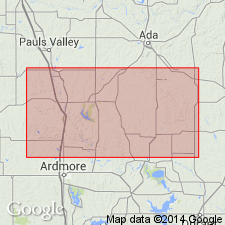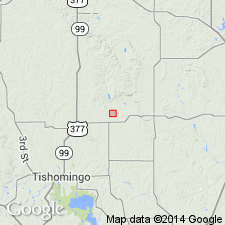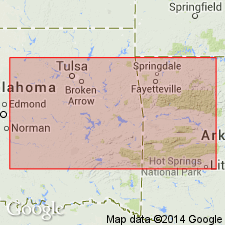
- Usage in publication:
-
- Ahlosa member
- Modifications:
-
- Original reference
- Dominant lithology:
-
- Shale
- Limestone
- AAPG geologic province:
-
- South Oklahoma folded belt
Summary:
Pg. 60-62, 70 (table 2). Ahlosa member, basal member of Caney shale. Commonly referred to as "Mayes" or "Ada Mayes." Consists of dark-gray, fine-grained, coarsely laminated to nearly massive calcareous shale. Thickness 25 to 190 feet. Underlies Delaware Creek member (new); contact placed where shales change to soft, noncalcareous, finely laminated, concretion-bearing shale. Overlies Welden limestone; contact placed at glauconitic zone above Welden. Fossiliferous (conodonts, brachiopods, pelecypods, cephalopods, ostracods). Present in northern Arbuckle Mountains, south-central Oklahoma; absent from southern Arbuckles. Age is Late Mississippian (Meramec).
Type locality: in NE/4 sec. 14, T.2 S., R.7 E., Johnston Co., OK. Named from village at junction of Highways 99 and 3, about 3 mi southeast of Ada, in sec. 14, T. 3 N., R. 6 E., Pontotoc Co., OK.
Source: US geologic names lexicon (USGS Bull. 1200, p. 30); supplemental information from GNU records (USGS DDS-6; Denver GNULEX).

- Usage in publication:
-
- Ahloso member
- Modifications:
-
- [Principal reference]
- AAPG geologic province:
-
- South Oklahoma folded belt
Summary:
Pg. 5, 7, 21. Name emended to Ahloso. Type section designated. Thickness 49.2 feet. Age is Late Mississippian (Meramec).
Type section: beds 10 to 18, measured section D, in sec. 14, T. 2 S., R. 7 E., Johnston Co., south-central OK.
Source: US geologic names lexicon (USGS Bull. 1200, p. 30).

- Usage in publication:
-
- Ahloso Member*
- Modifications:
-
- Adopted
Summary:
Pg. A2-A3, A54, A56-A57 (fig. 5). Ahlosa Member (name amended to Ahloso by Elias and Branson, 1959) of Elias (1956) adopted as lowermost of three members of Caney Shale. Underlies Delaware Creek Member of Caney. Present in northern Arbuckle Mountains, south-central Oklahoma. Equivalent to Sycamore Limestone of southern Arbuckle Mountains. Age is Late Mississippian (Meramecian; early late Visean of Europe); foram zone 15. [See also Mackenzie Gordon, Jr., and G.C. Stone, 1976, Arkansas Geol. Commission Symposium on the geology of the Ouachita Mountains, v. 1.]
Source: Publication.
For more information, please contact Nancy Stamm, Geologic Names Committee Secretary.
Asterisk (*) indicates published by U.S. Geological Survey authors.
"No current usage" (†) implies that a name has been abandoned or has fallen into disuse. Former usage and, if known, replacement name given in parentheses ( ).
Slash (/) indicates name conflicts with nomenclatural guidelines (CSN, 1933; ACSN, 1961, 1970; NACSN, 1983, 2005, 2021). May be explained within brackets ([ ]).

